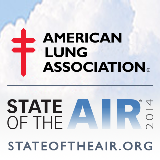Charlotte Observer
“Charlotte Drops off the list of Smoggiest Cities”
By Bruce Henderson
April 30, 2014
Metro Charlotte has for the first time dropped off the American Lung Association’s annual list of smoggiest U.S cities.
Charlotte’s been a regular on the list of ozone-polluted metro areas since the list began in 2000. The city has struggled for decades to meet the federal ozone standards, largely because of tailpipe emissions.
Ozone, sometimes called smog, poses a public health problem. The invisible gas forms in hot, sunny weather and can trigger asthma attacks and worsen the respiratory conditions.
But the rankings released Wednesday don’t include Charlotte among the 25 cities with the worse ozone pollution. The lung association also ranks the cities and counties for soot-like particle pollution.
Metro Charlotte has improved in the ratings in recent years, dropping from eight in worst in 2009 to 19th in 2013. The rankings ate based on data collected over three-year periods.
Don’t make too much of Charlotte’s absence this year, the association warns. Ozone worsened over much of the country because of unusually hot weather in two recent summers. Charlotte benefited by comparison.
Daily North Carolina air quality forecasts ate available by email at www.ncair.org/airware/enviroflash/.
Charlotte-area “clean” commuters can compete for a free trip to Wrightsville Beach at www.racetothebeach.com.
“It’s a little misleading, only because other areas had worse pollution” said Susan Berryman-Rodriguez, project director for Mothers & Others for Clean Air. The program is part of the American Lung Association’s work in the Southeast.
The association says 122,000 Mecklenburg County residents have lung diseases. An additional 242,000 people are under 18 and 91,000 over 65, and both groups are vulnerable to air pollution.
Mecklenburg had an average of two more bad- air days in 2010-12, reflected in this years report, than in 2009-11. Seven North Carolina counties, including Lincoln west of Charlotte, also had worsening ozone levels.
This week’s rankings don’t include a record low year for ozone in 2013. The Charlotte region never broke the federal standard that summer, when frequent rain inhibited the conditions that breed ozone.
But cleaner vehicle standards and a state crackdown on emissions from coal-fired power plants, which form ozone, also contributed.
Previous years with weather similar to last years tallied more smoggy days.
The 2013 results “were also because of real emission reductions in the region”, said Leslie Rhodes, Mecklenburg County’s air –quality director. “I think that’s telling”.
The overall trend is toward lower emissions and ozone levels, she said.
The Charlotte region still hasn’t met a newer, tougher ozone standard set in 2008. The deadline to meet that federal standard is the end of 2015. Rhodes said it might be attained sooner if conditions remain good this summer.
The Charlotte regional Transportation Planning Organization certified APRIL 16 that future road-building projects using federal money won’t make air pollution worse. The determinations are required every four years.





